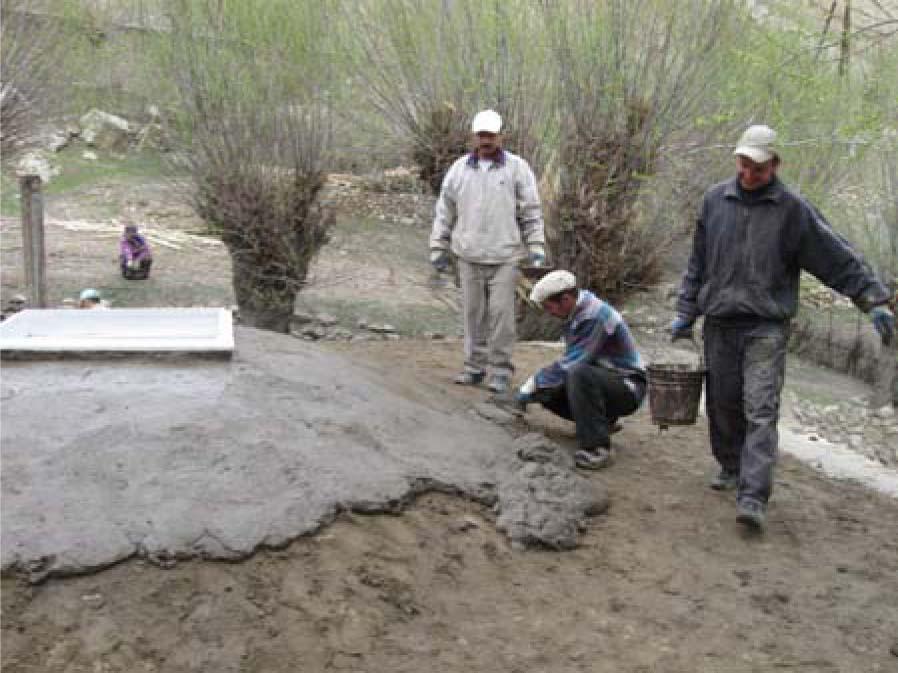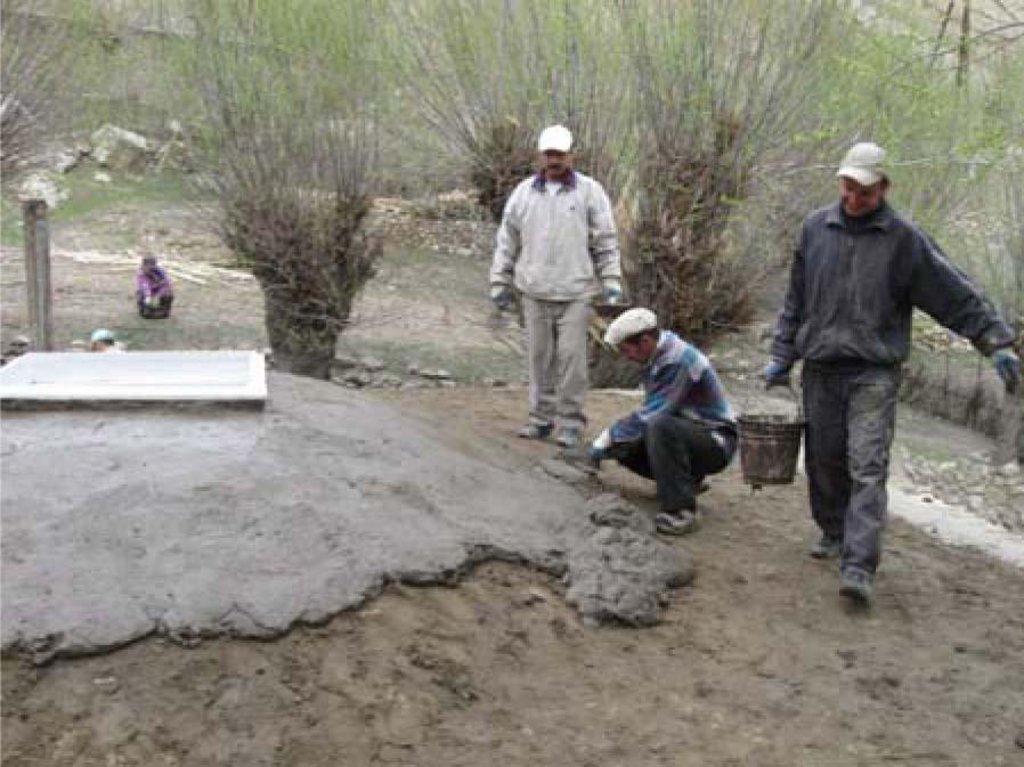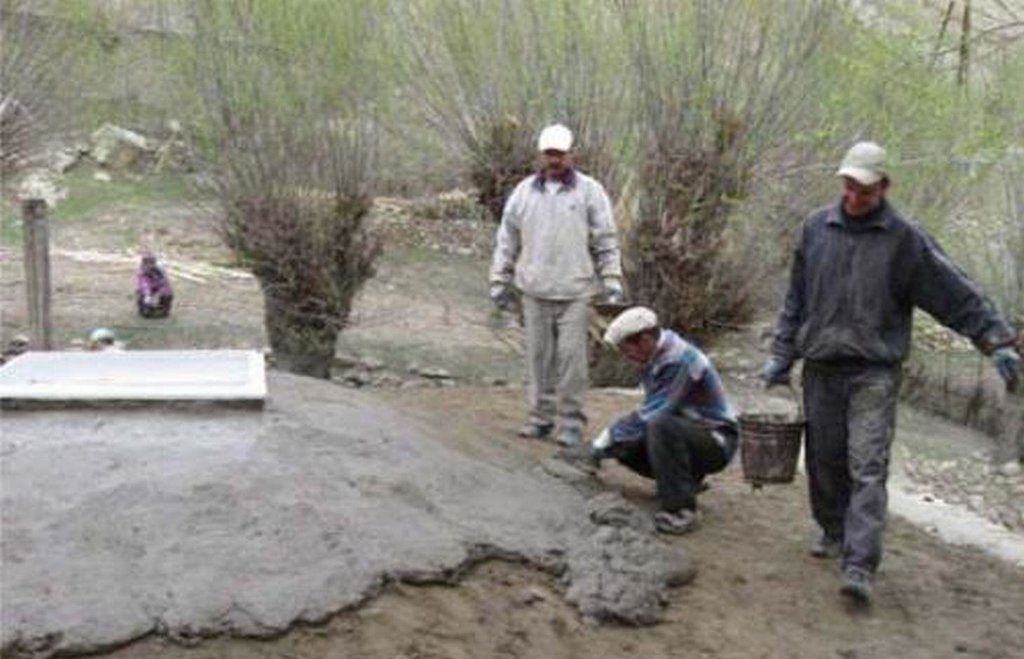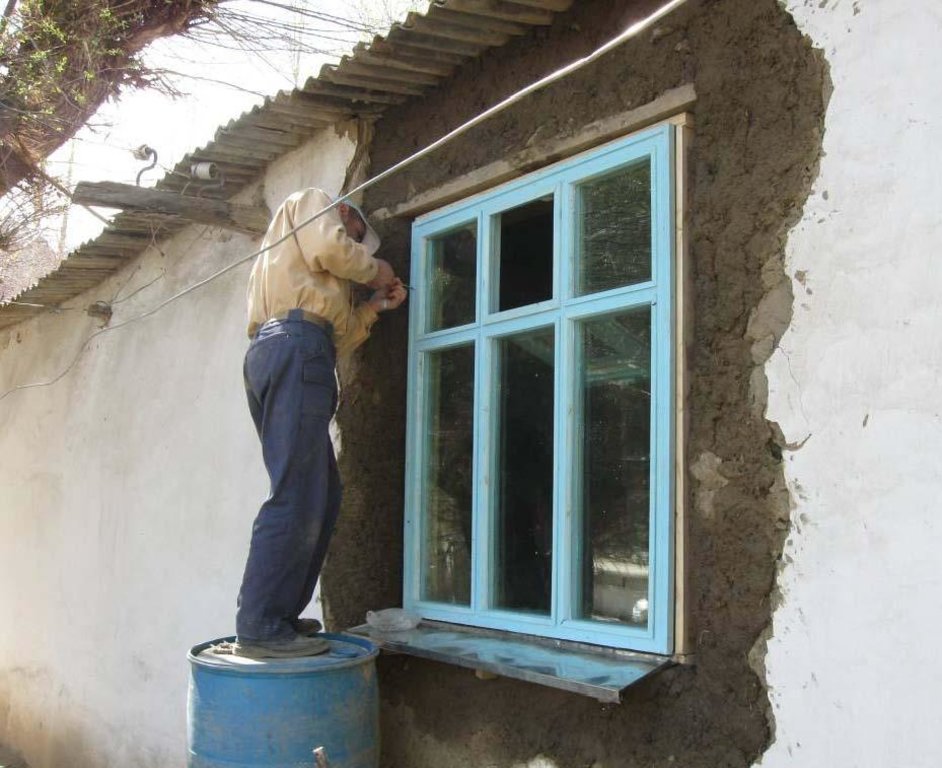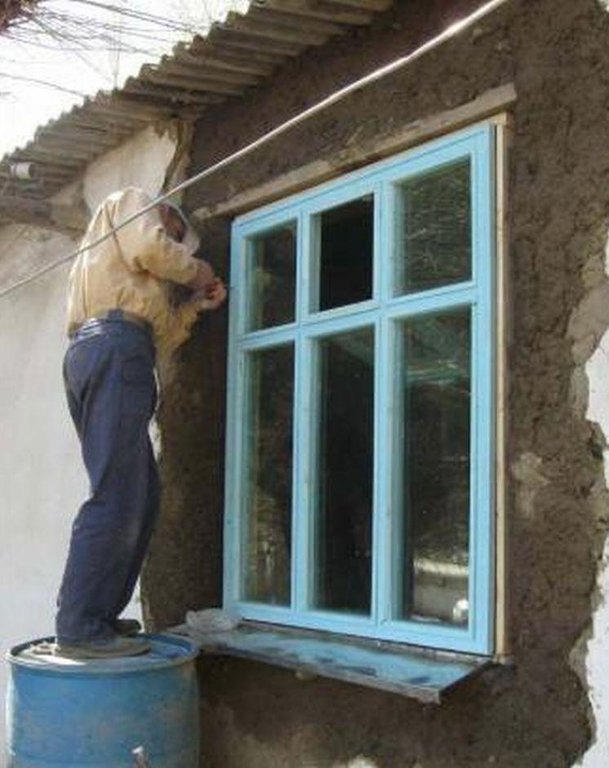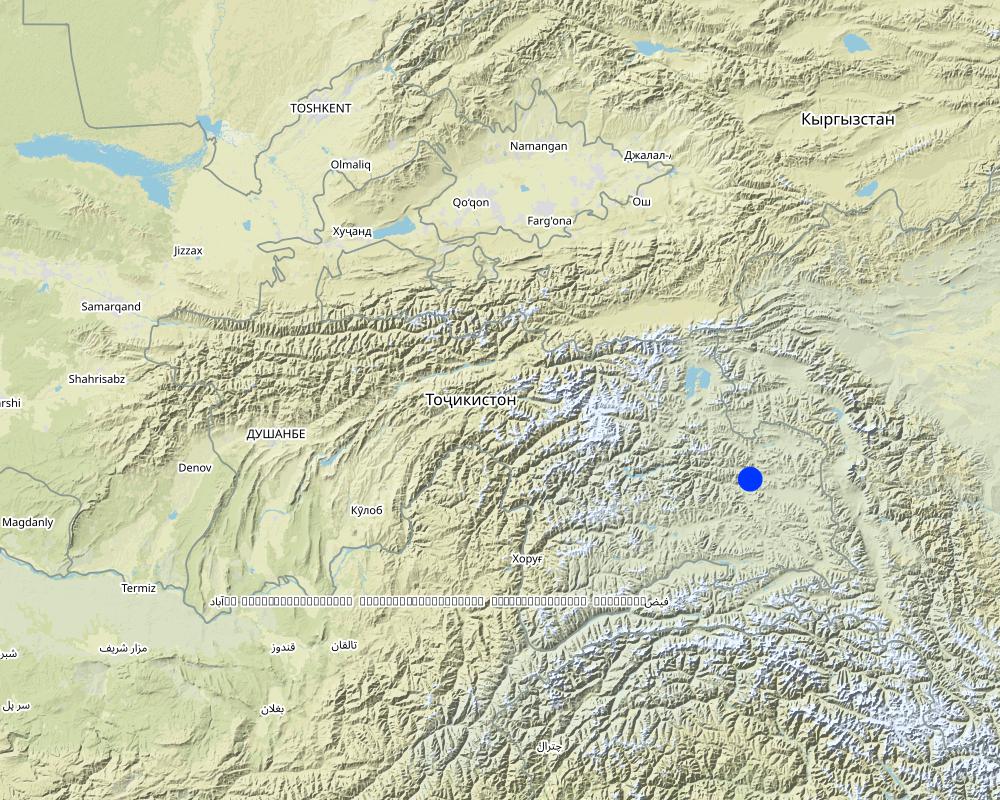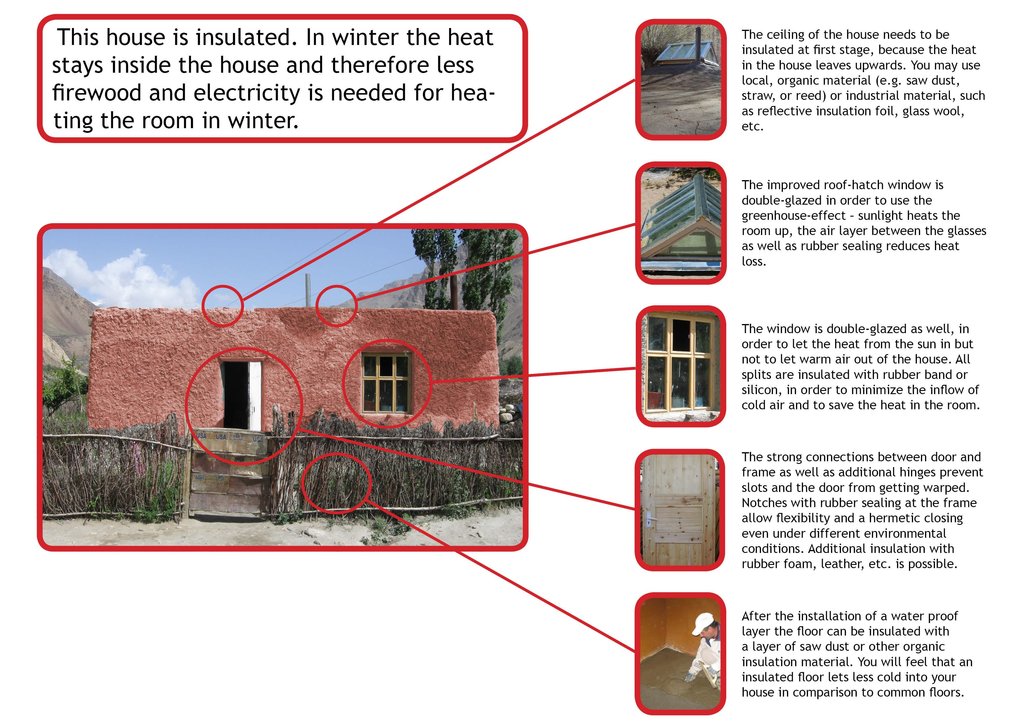Reduced pressure on forest resources by improved thermal insulation in private houses [ប្រទេសតាហ្ស៊ីគីស្ថាន]
- ការបង្កើត៖
- បច្ចុប្បន្នភាព
- អ្នកចងក្រង៖ Roziya Kirgizbekova
- អ្នកកែសម្រួល៖ –
- អ្នកត្រួតពិនិត្យច្រើនទៀត៖ Alexandra Gavilano, Deborah Niggli, Joana Eichenberger
Central Asian Countries Initiative for Land Management (CACILM/ИСЦАУЗР)
technologies_1459 - ប្រទេសតាហ្ស៊ីគីស្ថាន
- សង្ខេបជា PDF
- សេចក្តីសង្ខេបពេញលេញជាទម្រង់ PDF សម្រាប់បោះពុម្ព
- សេចក្តីសង្ខេបពេញលេញទម្រង់អ៊ីនធឺនេត
- សេចក្តីសង្ខេបពេញលេញ (មិនមានទម្រង់ជាក់លាក់)
- Reduced pressure on forest resources by improved thermal insulation in private houses: 4 ខែ មករា ឆ្នាំ 2017 (inactive)
- Reduced pressure on forest resources by improved thermal insulation in private houses: 19 ខែ កក្កដា ឆ្នាំ 2017 (inactive)
- Reduced pressure on forest resources by improved thermal insulation in private houses: 20 ខែ សីហា ឆ្នាំ 2019 (inactive)
- Reduced pressure on forest resources by improved thermal insulation in private houses: 2 ខែ វិច្ឆិកា ឆ្នាំ 2021 (public)
ពិនិត្យមើលគ្រប់ផ្នែក
ពង្រីកមើលទាំងអស់ បង្រួមទាំងអស់1. ព័ត៌មានទូទៅ
1.2 ព័ត៌មានលម្អិតពីបុគ្គលសំខាន់ៗ និងស្ថាប័នដែលចូលរួមក្នុងការវាយតម្លៃ និងចងក្រងឯកសារនៃបច្ចេកទេស
អ្នកជំនាញឯកទេស SLM:
Zevarshoev Rustam
Retail Cooperative "Zindagi"
ប្រទេសតាហ្ស៊ីគីស្ថាន
ឈ្មោះគម្រោងដែលបានចងក្រងឯកសារ/ វាយតម្លៃលើបច្ចេកទេស (បើទាក់ទង)
Central Asian Countries Initiative for Land Management (CACILM I)ឈ្មោះគម្រោងដែលបានចងក្រងឯកសារ/ វាយតម្លៃលើបច្ចេកទេស (បើទាក់ទង)
Pilot Program for Climate Resilience, Tajikistan (WB / PPCR)1.3 លក្ខខណ្ឌទាក់ទងទៅនឹងការប្រើប្រាស់ទិន្នន័យដែលបានចងក្រងតាមរយៈ វ៉ូខេត
អ្នកចងក្រង និង(បុគ្គលសំខាន់ៗ)យល់ព្រមទទួលយកនូវលក្ខខណ្ឌនានាទាក់ទងទៅនឹងការប្រើប្រាស់ទិន្នន័យដែលបានចងក្រងតាមរយៈវ៉ូខេត:
បាទ/ចា៎
1.4 សេចក្តីប្រកាសស្តីពីចីរភាពនៃការពណ៌នាពីបច្ចេកទេស
តើបច្ចេកទេសដែលបានពណ៌នានេះមានបញ្ហាដែលផ្តោតលើការធ្លាក់ចុះគុណភាពដី, បើដូច្នេះវាមិនអាចត្រូវបានប្រកាសថាជាបច្ចេកទេសនៃការគ្រប់គ្រងប្រកបដោយចីរភាពទេ?
ទេ
1.5 ការយោងទៅលើកម្រងបញ្ជីសំណួរ (មួយ ឬច្រើន) នៃវិធីសាស្ត្រផ្សព្វផ្សាយ SLM (ដែលបានចងក្រងដោយទស្សនៈពិភពលោកស្តីពីវិធីសាស្ត្រ និងបច្ចេកទេសងអភិរក្ស WOCAT)
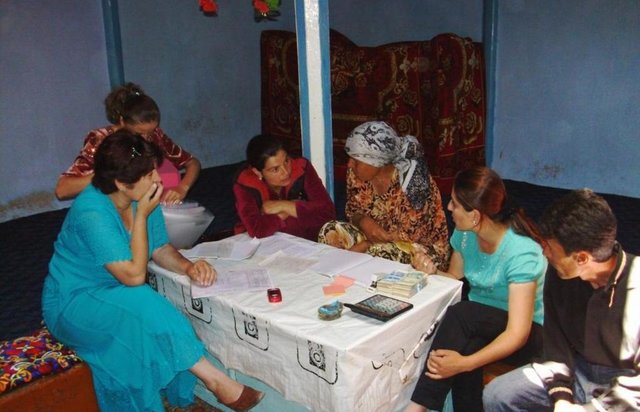
Access to thermal insulation through micro loans [ប្រទេសតាហ្ស៊ីគីស្ថាន]
Provision of small scale loans for private households to ensure access to thermal insulation (in the frame of CACILM).
- អ្នកចងក្រង៖ Roziya Kirgizbekova
2. ការពណ៌នាពីបច្ចេកទេស SLM
2.1 ការពណ៌នាដោយសង្ខេបពីបច្ចេកទេស
និយមន័យបច្ចេកទេស:
Thermal insulation of private houses with energy efficient products to reduce the fuel-wood demand and pressures on the natural environment.
2.2 ការពណ៌នាលម្អិតពីបច្ចេកទេស
ការពណ៌នា:
Well insulated doors and windows are installed together with thermal insulation of the ceilings and floors in houses in the remote villages of the Gorno-Badakhshan Autonomous Region. Improved quality windows and doors, as well as improved thermal insulation of the houses contribute to retain the heat inside, which is one of the main problems in many of these traditionally built houses. The quality of the materials used to produce the products as well as the quality of the product itself and its installation process are ensured through using locally trained craftsmen. Local available organic materials such as sawdust, straw, water plants, leaves and others can be used as thermal insulation material for walls, floors and ceilings. The materials should be dry and free of insects. The local labour market plays a crucial role in the technical accurate performance of the thermal insulation measures. Therefore the local labour market has to be analysed and training needs for the craftsmen have to be defined, e.g. for producing double-glazed windows and improved doors, as well as insulating walls, ceilings or floors, and the installation of windows and doors in accordance to the defined and standardised thermal insulation measu
Thermal insulation contributes to the reduction of heat exchange between indoors and outdoors and therefore may have two main effects: Less fuel may be needed to heat the houses, or using the same quantities of fuel the temperature indoors can be significantly increased. A reduction in fuel consumption means a reduction either of financial expenses or of labour, so the saved money or time can be used for other purposes - ideally for making investments and creating additional income sources. Higher and more constant indoor temperatures can contribute to a reduction in health risks and to increased quality of life during the winter period. Going beyond the level of the individual household, a reduction in fuel consumption means less pressure on natural resources: The less firewood that is used for heating, the less trees will be cut down and the less the forests will degrade. Also the less manure that is burnt in the stoves means more of it can be used as fertilizer on the arable land. In this framework many of the economical, social and environmental problems could be mitigated if houses were properly insulated.
A technical assessment of the identified house for thermal insulation is carried out to investigate which materials are used for the construction of the house, and to identify measures and materials that could be used for thermal insulation purposes, in order to be able to offer the most technically appropriate solution, which is adapted to the local cultural and climatic conditions. The organic thermal insulation material should be prepared in advance to make sure it is dry and clean. The designated area whether it is the floor, ceiling or walls should be cleared of furniture and other things items. Electric wires should be safely removed, or covered adequately for safety reasons to prevent fire. In the case of the roof, the insulation material is laid out evenly on the surface to a thickness of 15-20 cm depending on the type of organic material which is used. The lime is then spread out over the organic insulation material. For 1 m2 about 1-1.5kg of lime is required. The material is thoroughly tamped down to reduce subsidence of the protective cover, which will be put over the insulation material. A mixture of clay, straw and water is prepared to form a substance with a solid consistency to prevent the surface from cracking when it dries. This clay and straw mixture is then spread evenly on the surface about 4-6 cm thick, ensuring that the whole insulation material is covered. The surface should dry in 24 hours after which some cracks might appear and if this happens then a liquid mixture of clay and sand is used to flatten the area left to dry again. The same process is applied to the floors, and the more complex roof thermal insulation materials where roof felt is used as a basis for the organic insulation material as it is moisture proof. The windows and doors as well as these insulated areas in the house should be properly maintained. It should be ensures that there are no leaks in the roof so that the ceiling insulation is kept dry.
Riparian forests in the Western parts of Gorno-Badakhshan and Teresken shrubs on the high plains in the Eastern parts are almost completely destroyed due to their excessive use as a fuel for heating and cooking, and their overuse as areas for pastures. Manure, as one important natural fertilizer for agriculture, is no longer available in large quantities and so the fertility of soil has decreased. In the Eastern Pamirs, although the area is scarcely populated, Teresken shrubs have been used excessively as a fuel and are no longer found within 70km around the only major settlement of Murgab, which has resulted in massive soil erosion and degradation of pastures in this area. The situation is worsened by the fact that the local, mostly traditionally built houses are poorly insulated, low quality doors and windows do not preserve the heat inside during severe cold temperatures. Constant heating is thus necessary meaning households burn large amount of natural fuel resources to keep their houses warm. The thermal insulation technology should contribute to ease the pressure on the natural resources in the GBAO area and allow natural regeneration of forests and Teresken shrubs.
2.3 រូបភាពនៃបច្ចេកទេស
2.5 ប្រទេស/តំបន់/ទីតាំងកន្លែង ដែលបច្ចេកទេសត្រូវបានអនុវត្ត និងបានគ្រប់ដណ្តប់ដោយការវាយតម្លៃនេះ
ប្រទេស:
ប្រទេសតាហ្ស៊ីគីស្ថាន
តំបន់/រដ្ឋ/ខេត្ត:
Tajikistan, Gorno Badakhshan Autonomous Oblast (GBAO)
បញ្ជាក់បន្ថែមពីលក្ខណៈនៃទីតាំង:
Roshtkala, Shugnan, Murgab and Ishkashim
បញ្ជាក់ពីការសាយភាយនៃបច្ចេកទេស:
- ត្រូវបានផ្សព្វផ្សាយត្រឹមតំបន់មួយ
ប្រសិនបើមិនច្បាស់ពីទំហំផ្ទៃដី សូមធ្វើការប៉ាន់ប្រម៉ាណ:
- 100-1,000 គម2
មតិយោបល់:
The technology was implemented in several regions of GBAO.
Map
×2.6 កាលបរិច្ឆេទនៃការអនុវត្ត
ប្រសិនបើមិនច្បាស់ឆ្នាំ សូមបញ្ជាក់កាលបរិច្ឆេទដែលប្រហាក់ប្រហែល:
- តិចជាង 10ឆ្នាំមុន (ថ្មី)
2.7 ការណែនាំពីបច្ចេកទេស
សូមបញ្ជាក់តើបច្ចេកទេសត្រូវបានណែនាំឱ្យអនុវត្តដោយរបៀបណា:
- តាមរយៈគម្រោង / អន្តរាគមន៍ពីខាងក្រៅ
មតិយោបល់ (ប្រភេទនៃគម្រោង ។ល។):
The technology was developed and introduced through GIZ project. Gradually Retail Cooperative "Zindagi", established by GIZ is taking the project over.
3. ចំណាត់ថ្នាក់នៃបច្ចេកទេស SLM
3.1 គោលបំណងចម្បង (១ ឬច្រើន) នៃបច្ចេកទេសនេះ
- បង្កើតផលប្រយោជន៍សេដ្ឋកិច្ច
3.2 ប្រភេទដីប្រើប្រាស់មួយប្រភេទ (ច្រើនប្រភេទ) ដែលបានអនុវត្តបច្ចេកទេស

ដីព្រៃ/ដីដាំដើមឈើ
- ព្រៃ (ពាក់កណ្តាល) ធម្មជាតិ/ ដីព្រៃ
ព្រៃ (ពាក់កណ្តាល) ធម្មជាតិ / ដីព្រៃ៖ បញ្ជាក់ប្រភេទនៃការគ្រប់គ្រង:
- កាប់តែមួយចំនួន
ផលិតផល និងសេវាកម្ម:
- ឈើហ៊ុប
- អុស
- ផ្លែឈើ និងគ្រាប់ធញ្ញជាតិ
- វាលស្មៅ

លំនៅដ្ឋាន ហេដ្ឋារចនាសម្ព័ន្ធ
- ខ្សែបណ្តាញថាមពល៖ បំពង់ហ្គាស បណ្តាញខ្សែអគ្គិសនី
មតិយោបល់:
Major land use problems (compiler’s opinion): Due to a shortage of energy sources, wood, teresken and manure are extensively used for heating private houses; natural resources are therefore severely overused, which has resulted in degraded land, destroyed forests and lack of natural fertilizer for agriculture; poor thermal insulation of houses also leads to increased demand for fuel.
Major land use problems (land users’ perception): Unable to heat their houses properly during cold winters; shortage of fuel for cooking and heating; during cold winters, fire wood becomes so scarce that even fruit trees are cut down.
3.3 បន្ទាប់ពីអនុវត្តបច្ចេកទេស តើដីប្រើប្រាស់មានការប្រែប្រួលដែររឺទេ?

លំនៅដ្ឋាន ហេដ្ឋារចនាសម្ព័ន្ធ
3.5 ក្រុម SLM ដែលបច្ចេកទេសស្ថិតនៅក្នុង
- បច្ចេកទេសប្រើប្រាស់ថាមពលមានប្រសិទ្ធភាព
3.6 វិធានការ SLM ដែលបញ្ចូលនូវបច្ចេកទេស

វិធានការរុក្ខជាតិ
- V5: ផ្សេងៗ

វិធានការរចនាស័ម្ពន្ធ
- S11: ផ្សេងៗ

វិធានការគ្រប់គ្រង
- M2: ការផ្លាស់ប្តូរការគ្រប់គ្រង/ កម្រិតអាំងតង់ស៊ីតេ
3.7 កំណត់ប្រភេទនៃការធ្លាក់ចុះគុណភាពដីសំខាន់ៗដែលបច្ចេកទេសនេះបានដោះស្រាយ

ការហូរច្រោះដីដោយសារទឹក
- Wt: ការបាត់ដីស្រទាប់លើដោយការហូរច្រោះ

ការធ្លាក់ចុះជីវសាស្ត្រនៃដី
- Bc: ការថយចុះនូវគម្របរុក្ខជាតិ
- Bq: ការថយចុះនូវជីវម៉ាស/ បរិមាណ
- Bs: សមាសភាពដែលមានគុណភាពនិងប្រភេទសត្វ/ការថយចុះនូវជីវចម្រុះ
មតិយោបល់:
Main causes of degradation: over-exploitation of vegetation for domestic use (Exploiting forest resources for heating and cooking.), poverty / wealth (Most people can't afford to buy other fuel such as coal or gas.), Lack of finances
Secondary causes of degradation: change in temperature (Extremely cold winters force people to cut down excessive amounts of wood for fuel), change of seasonal rainfall (Less precipitation), Heavy / extreme rainfall (intensity/amounts) (Heavy periods of rainfall), population pressure (Population growth leads to increasing demand for wood for fuel.), Destroyed infrastructure
3.8 ការពារ កាត់បន្ថយ ឬស្តារឡើងវិញនៃការធ្លាក់ចុះគុណភាពដី
បញ្ជាក់ពីគោលដៅរបស់បច្ចេកទេស ដែលផ្តោតទៅការធ្លាក់ចុះគុណភាពដី:
- ការការពារការធ្លាក់ចុះគុណភាពដី
4. បច្ចេកទេសជាក់លាក់ សកម្មភាពអនុវត្ត ធាតុចូល និងថ្លៃដើម
4.1 គំនូសបច្ចេកទេសនៃបច្ចេកទេសនេះ
លក្ខណៈពិសេសនៃបច្ចេកទេស (ទាក់ទងនឺងគំនូរបច្ចេកទេស):
This diagram with photos shows the different thermal insulation measures.
Location: Ishkashim. Ishkashim, GBAO, Tajikisatan
Date: 26-02-2011
Technical knowledge required for field staff / advisors: high (Increased technical knowledge)
Technical knowledge required for craftsmen: high (Increased skills in producing well insulated doors and windows.)
Technical knowledge required for construction workers: high (Advanced skills in installation of thermal insulation products.)
Main technical functions: increase of biomass (quantity), Reduced heat loss from houses, Reduced fuel consumption
Secondary technical functions: improvement of topsoil structure (compaction), stabilisation of soil (eg by tree roots against land slides), increase in organic matter, increase in nutrient availability (supply, recycling,…), promotion of vegetation species and varieties (quality, eg palatable fodder)
Change of land use practices / intensity level
ឈ្មោះអ្នកនិពន្ធ:
Tajikistan
4.2 ព័ត៌មានទូទៅដែលពាក់ព័ន្ធនឹងការគណនាធាតុចូល និងថ្លៃដើម
ផ្សេងៗ/ រូបិយប័ណ្ណជាតិ (បញ្ជាក់):
somoni
បើពាក់ព័ន្ធសូមកំណត់អត្រាប្តូរប្រាក់ពីដុល្លាទៅរូបិយប័ណ្ណតំបន់ (ឧ. 1 ដុល្លារ = 79.9 រៀលនៃរូបិយប័ណ្ណប្រេស៊ីល) ៖ 1 ដុល្លារ =:
4,6
4.3 សកម្មភាពបង្កើត
| សកម្មភាព | រយៈពេល (រដូវកាល) | |
|---|---|---|
| 1. | Installation of window 1.40x1.30 | Any time |
| 2. | Installation of door 2.00x0.90 | |
| 3. | Thermal insulation |
4.4 ថ្លៃដើម និងធាតុចូលដែលត្រូវការសម្រាប់ការបង្កើតបច្ចេកទេស
| បញ្ជាក់ពីធាតុចូល | ឯកតា | បរិមាណ | ថ្លៃដើមក្នុងមួយឯកតា | ថ្លៃធាតុចូលសរុប | % នៃថ្លៃដើមដែលចំណាយដោយអ្នកប្រើប្រាស់ដី | |
|---|---|---|---|---|---|---|
| កម្លាំងពលកម្ម | labour | ha | 1,0 | 17,0 | 17,0 | 100,0 |
| សម្ភារៈសាងសង់ | door | ha | 1,0 | 133,0 | 133,0 | 100,0 |
| សម្ភារៈសាងសង់ | window | ha | 1,0 | 126,0 | 126,0 | 100,0 |
| សម្ភារៈសាងសង់ | Isolation material | ha | 1,0 | 126,0 | 126,0 | 100,0 |
| ថ្លៃដើមសរុបក្នុងការបង្កើតបច្ចេកទេស | 402,0 | |||||
| ថ្លៃដើមសរុបក្នុងការបង្កើតបច្ចេកទេសគិតជាដុល្លារ | 87,39 | |||||
4.6 កំណត់ថ្លៃដើមសម្រាប់ការថែទាំ/ សកម្មភាពរបស់បច្ចេកទេស (ក្នុងរយៈពេលមួយឆ្នាំ)
មតិយោបល់:
The labour costs are indicated for installation of one window/door. With regards to the thermal insulation the labour costs are higher, so they are calculated per square metre of the area where thermal insulation will be applied.
4.7 កត្តាសំខាន់បំផុតដែលមានឥទ្ធិពលដល់ការចំណាយ
ពណ៌នាពីកត្តាប៉ះពាល់ចម្បងៗទៅលើថ្លៃដើម:
The costs for the installation of windows and doors depends on their size and also whether additional work has to be done to fit the door or window hatch to the required size. With regards to the thermal insulation the costs are estimated based of the size of the area in square metres, whether it is the floor, ceiling or wall.
5. លក្ខណៈបរិស្ថានធម្មជាតិ និងមនុស្ស
5.1 អាកាសធាតុ
បរិមាណទឹកភ្លៀងប្រចាំឆ្នាំ
- < 250 មម
- 251-500 មម
- 501-750 មម
- 751-1,000 មម
- 1,001-1,500 មម
- 1,501-2,000 មម
- 2,001-3,000 មម
- 3,001-4,000 មម
- > 4,000 មម
លក្ខណៈពិសេស/ មតិយោបល់លើរដូវភ្លៀង:
In Murghab District annual rainfall is below 200mm. Around Khorog annual rainfall is 480mm.
តំបន់កសិអាកាសធាតុ
- ស្ងួត
Thermal climate class: temperate, boreal
5.2 សណ្ឋានដី
ជម្រាលជាមធ្យម:
- រាបស្មើ (0-2%)
- ជម្រាលតិចតួច (3-5%)
- មធ្យម (6-10%)
- ជម្រាលខ្ពស់បន្តិច (11-15%)
- ទីទួល (16-30%)
- ទីទួលចោត (31-60%)
- ទីទួលចោតខ្លាំង (>60%)
ទម្រង់ដី:
- ខ្ពង់រាប
- កំពូលភ្នំ
- ជម្រាលភ្នំ
- ជម្រាលទួល
- ជម្រាលជើងភ្នំ
- បាតជ្រលងភ្នំ
តំបន់តាមរយៈកម្ពស់ :
- 0-100 ម
- 101-500 ម
- 501-1,000 ម
- 1,001-1,500 ម
- 1,501-2,000 ម
- 2,001-2,500 ម
- 2,501-3,000 ម
- 3,001-4,000 ម
- > 4,000 ម
5.3 ដី
ជម្រៅដីជាមធ្យម:
- រាក់ខ្លាំង (0-20 សម)
- រាក់ (21-50 សម)
- មធ្យម (51-80 សម)
- ជ្រៅ (81-120 សម)
- ជ្រៅខ្លាំង (> 120 សម)
វាយនភាពដី (ស្រទាប់លើ):
- គ្រើម/ មានពន្លឺ (ខ្សាច់)
សារធាតុសរីរាង្គនៅស្រទាប់ដីខាងលើ:
- មធ្យម (1-3%)
- ទាប (<1%)
5.4 ទឹកដែលអាចទាញមកប្រើប្រាស់បាន និងគុណភាពទឹក
នីវ៉ូទឹកក្រោមដី:
5-50 ម
ទឹកលើដីដែលអាចទាញយកប្រើប្រាស់បាន:
ល្អ
គុណភាពទឹក (មិនបានធ្វើប្រត្តិកម្ម):
ទឹកពិសារដែលមានគុណភាពល្អ
5.5 ជីវៈចម្រុះ
ភាពសម្បូរបែបនៃប្រភេទ:
- ខ្ពស់
5.6 លក្ខណៈនៃអ្នកប្រើប្រាស់ដីដែលអនុវត្តបច្ចេកទេស
ទីផ្សារនៃប្រព័ន្ធផលិតកម្ម:
- សម្រាប់ហូបក្នុងគ្រួសារ (ផ្គត់ផ្គង់ខ្លួនឯង)
ចំណូលក្រៅកសិកម្ម:
- ច្រើនជាង 50% នៃចំណូល
កម្រិតជីវភាព:
- មិនល្អ
- មធ្យម
ឯកជន ឬក្រុម:
- ធ្វើខ្លួនឯង/ គ្រួសារ
យេនឌ័រ:
- ស្ត្រី
- បុរស
សូមបញ្ជាក់ពីលក្ខណៈពាក់ព័ន្ធផ្សេងទៀតអំពីអ្នកប្រើប្រាស់ដី:
Land users applying the Technology are mainly Leaders / privileged
Population density: 10-50 persons/km2
Annual population growth: 2% - 3% (If creditworthy, they can participate through micro-loans schemes.).
Off-farm income specification: The majority of households rely heavily on remittances from Russia.
5.7 ទំហំផ្ទៃដីជាមធ្យមនៃដីប្រើប្រាស់ដោយអ្នកប្រើប្រាស់ដី ក្នុងការអនុវត្តបច្ចេកទេស
- < 0.5 ហិកតា
- 0.5-1 ហិកតា
- 1-2 ហិកតា
- 2-5 ហិកតា
- 5-15 ហិកតា
- 15-50 ហិកតា
- 50-100 ហិកតា
- 100-500 ហិកតា
- 500-1,000 ហិកតា
- 1,000-10,000 ហិកតា
- > 10,000 ហិកតា
តើផ្ទៃដីនេះចាត់ទុកជាទំហំកម្រិតណាដែរ ខ្នាតតូច មធ្យម ឬខ្នាតធំ (ធៀបនឹងបរិបទតំបន់)?
- ខ្នាតតូច
5.8 ភាពជាម្ចាស់ដី កម្មសិទ្ធប្រើប្រាស់ដី និងកម្មសិទ្ធប្រើប្រាស់ទឹក
ភាពជាម្ចាស់ដី:
- រដ្ឋ
កម្មសិទ្ធិប្រើប្រាស់ដី:
- កិច្ចសន្យាជួល
5.9 ការប្រើប្រាស់សេវាកម្ម និងហេដ្ឋារចនាសម្ព័ន្ធ
សុខភាព:
- មិនល្អ
- មធ្យម
- ល្អ
ការអប់រំ:
- មិនល្អ
- មធ្យម
- ល្អ
ជំនួយបច្ចេកទេស:
- មិនល្អ
- មធ្យម
- ល្អ
ការងារ (ឧ. ការងារក្រៅកសិដ្ឋាន):
- មិនល្អ
- មធ្យម
- ល្អ
ទីផ្សារ:
- មិនល្អ
- មធ្យម
- ល្អ
ថាមពល:
- មិនល្អ
- មធ្យម
- ល្អ
ផ្លូវ និងការដឹកជញ្ជូន:
- មិនល្អ
- មធ្យម
- ល្អ
ទឹកផឹក និងអនាម័យ:
- មិនល្អ
- មធ្យម
- ល្អ
សេវាកម្មហិរញ្ញវត្ថុ:
- មិនល្អ
- មធ្យម
- ល្អ
6. ផលប៉ះពាល់ និងការសន្និដ្ឋាន
6.1 ផលប៉ះពាល់ក្នុងបរិវេណអនុវត្តបច្ចេកទេសដែលកើតមាន
ផលប៉ះពាល់លើសេដ្ឋកិច្ចសង្គម
ផលិតផល
ផលិតកម្មចំណីសត្វ
គុណភាពចំណីសត្វ
ផលិតកម្មសត្វ
ចំណូល និងថ្លៃដើម
ចំណូលក្នុងកសិដ្ឋាន
មតិយោបល់/ ការបញ្ជាក់:
Save money from buying fuel and electricity
ភាពសម្បូរបែបប្រភពប្រាក់ចំណូល
មតិយោបល់/ ការបញ្ជាក់:
Income of craftsmen increased.
បន្ទុកការងារ
មតិយោបល់/ ការបញ្ជាក់:
Less time needed for fire wood collection
ផលប៉ះពាល់ទៅលើវប្បធម៌សង្គម
ស្ថានភាពសុខភាព
មតិយោបល់/ ការបញ្ជាក់:
Warmer houses reduce health risks.
ចំណេះដឹង SLM / ការធ្លាក់ចុះគុណភាពដី
មតិយោបល់/ ការបញ្ជាក់:
Improved knowledge on energy efficiency and insulation measures.
ការកាត់បន្ថយជម្លោះ
ស្ថានភាពក្រុមដែលមានបញ្ហាក្នុងសង្គម និងសេដ្ឋកិច្ច
មតិយោបល់/ ការបញ្ជាក់:
Opportunity to improve living conditions and save money.
contribution to human well-being
មតិយោបល់/ ការបញ្ជាក់:
In general, people save money on energy sources and spend less time collecting wood and animal dung from the field. Houses are warmer, which can be beneficial for the family's health.
ផលប៉ះពាល់ទៅលើអេកូឡូស៊ី
វដ្តទឹក/លំហូរ
លំហូរទឹកលើផ្ទៃដី
រំហួត
ដី
សំណើមដី
គម្របដី
ជីវចម្រុះ៖ ដំណាំ, សត្វ
ជីវម៉ាស/ កាបូនលើដី
មតិយោបល់/ ការបញ្ជាក់:
Up to 45% less wood used for fuel.
ភាពសម្បូរបែបនៃរុក្ខជាតិ
ភាពសម្បូរបែបនៃទីជំរក
មតិយោបល់/ ការបញ្ជាក់:
In Murghab District teresken used as fire wood is the main fodder for wild animals (e.g. deer, gazelles)
6.2 ផលប៉ះពាល់ក្រៅបរិវេណអនុវត្តបច្ចេកទេសដែលកើតមាន
លំហូរទឹកដែលអាចប្រើប្រាស់បាននៅរដូវប្រាំង
មតិយោបល់/ ការបញ្ជាក់:
Protection of riparian forests.
ទឹកជំនន់ខ្សែទឹកខាងក្រោម
មតិយោបល់/ ការបញ្ជាក់:
Protection of riparian forests.
Buffering/សមត្ថភាពចម្រោះ
ខ្យល់នាំយកនូវធូរលី
ខូចខាតដល់ស្រែអ្នកជិតខាង
ខូចខាតដល់ហេដ្ឋារចនាសម្ព័ន្ធសាធារណៈ/ឯកជន
6.3 ភាពប្រឈម និងភាពរួសនៃបច្ចេកទេសទៅនឹងការប្រែប្រួលអាកាសធាតុ និងគ្រោះអាកាសធាតុ/ គ្រោះមហន្តរាយ (ដែលដឹងដោយអ្នកប្រើប្រាស់ដី)
ការប្រែប្រួលអាកាសធាតុ
ការប្រែប្រួលអាកាសធាតុ
| រដូវកាល | កើនឡើង ឬថយចុះ | លក្ខណៈឆ្លើយតបនៃបច្ចេកទេសទៅនឹងការប្រែប្រួលអាកាសធាតុ | |
|---|---|---|---|
| សីតុណ្ហភាពប្រចាំឆ្នាំ | កើនឡើង | ល្អ |
គ្រោះអាកាសធាតុ (មហន្តរាយ)
គ្រោះមហន្តរាយធម្មជាតិ
| លក្ខណៈឆ្លើយតបនៃបច្ចេកទេសទៅនឹងការប្រែប្រួលអាកាសធាតុ | |
|---|---|
| ព្យុះភ្លៀងតាមតំបន់ | ល្អ |
| ព្យុះកំបុតត្បូងតាមតំបន់ | មិនស្គាល់ |
គ្រោះមហន្តរាយអាកាសធាតុ
| លក្ខណៈឆ្លើយតបនៃបច្ចេកទេសទៅនឹងការប្រែប្រួលអាកាសធាតុ | |
|---|---|
| រាំងស្ងួត | ល្អ |
គ្រោះមហន្តរាយទឹក
| លក្ខណៈឆ្លើយតបនៃបច្ចេកទេសទៅនឹងការប្រែប្រួលអាកាសធាតុ | |
|---|---|
| ទឹកជំនន់ទូទៅ (ទន្លេ) | មិនស្គាល់ |
ផលវិបាកដែលទាក់ទងនឹងបរិយាកាសផ្សេងៗទៀត
ផលវិបាកដែលទាក់ទងនឹងបរិយាកាសផ្សេងៗទៀត
| លក្ខណៈឆ្លើយតបនៃបច្ចេកទេសទៅនឹងការប្រែប្រួលអាកាសធាតុ | |
|---|---|
| កាត់បន្ថយពេលដាំដុះ | ល្អ |
| Extreme cold temperatures | ល្អ |
6.4 ការវិភាគថ្លៃដើម និងអត្ថប្រយោជន៍
តើផលចំណេញ និងថ្លៃដើមត្រូវបានប្រៀបធៀបគ្នាយ៉ាងដូចម្តេច (ទស្សនៈរបស់អ្នកប្រើប្រាស់ដី)?
រយៈពេលខ្លី:
វិជ្ជមានតិចតួច
រយៈពេលវែង:
វិជ្ជមាន
តើផលចំណេញ និងការថែទាំ/ ជួសជុលត្រូវបានប្រៀបធៀបគ្នាយ៉ាងដូចម្តេច (ទស្សនៈរបស់អ្នកប្រើប្រាស់ដី)?
រយៈពេលខ្លី:
វិជ្ជមានខ្លាំង
រយៈពេលវែង:
វិជ្ជមានខ្លាំង
6.5 ការទទួលយកបច្ចេកទេស
មតិយោបល់:
168 land user families have adopted the Technology without any external material support
The households take a micro loan with an affordable low interest rate to install thermal insulation products. The micro loan is not provided in the form of cash, but in kind, i.e. the products and installation.
There is a moderate trend towards spontaneous adoption of the Technology
Comments on adoption trend: When one household installs quality windows or doors or has its house insulated, the effects are visible not only to that given household but also to neighbours and other visitors. As a result the number of people interested in installing such technology to their homes is increasing.
6.7 ភាពខ្លាំង/ គុណសម្បត្តិ/ ឱកាសនៃបច្ចេកទេស
| ភាពខ្លាំង/ គុណសម្បត្តិ/ ឱកាសនៅកន្លែងរបស់អ្នកប្រើប្រាស់ដី |
|---|
| Costs of firewood reduced |
| Warm and comfortable houses |
| Reduced workload |
| ភាពខ្លាំង/ គុណសម្បត្តិ/ ឱកាស ទស្សនៈរបស់បុគ្គលសំខាន់ៗ |
|---|
| If implemented on a larger scale can prevent overuse of natural resources for fuel. |
| Incentives in form of micro loans to make the technology more accessible to local people. |
| Reduced workload and costs spent on buying fuel. |
| Imported timber used to produce doors and windows. |
| More fertilizer available. |
6.8 ភាពខ្សោយ/ គុណវិបត្តិ/ ហានិភ័យនៃបច្ចេកទេស និងវិធីសាស្ត្រដោះស្រាយ
| ភាពខ្សោយ/ គុណវិបត្តិ/ ហានិភ័យ ទស្សនៈរបស់អ្នកចងក្រងឬបុគ្គលសំខាន់ៗ | តើបច្ចេកទេសទាំងនោះបានដោះស្រាយបញ្ហាដូចម្តេច? |
|---|---|
| Lack of skilled craftsmen | Improved professional craftsmen education through training courses. |
| Lack of modern equipment to produce wooden products | Financial support to supply the local craftsmen with modern equipment to further improve the quality of the products and increase the rate the production process. |
7. ឯកសារយោង និងវេបសាយ
7.1 វិធីសាស្ត្រ/ ប្រភពនៃព័ត៌មាន
- តាមការចុះទីវាល ការស្រាវជ្រាវនៅទីវាល
- ការសម្ភាសន៍ជាមួយអ្នកប្រើប្រាស់ដី
តើពេលណាដែលទិន្នន័យបានចងក្រង (នៅទីវាល)?
24/01/2011
ការតភ្ជាប់ និងម៉ូឌុល
ពង្រីកមើលទាំងអស់ បង្រួមទាំងអស់ការតភ្ជាប់

Access to thermal insulation through micro loans [ប្រទេសតាហ្ស៊ីគីស្ថាន]
Provision of small scale loans for private households to ensure access to thermal insulation (in the frame of CACILM).
- អ្នកចងក្រង៖ Roziya Kirgizbekova
ម៉ូឌុល
គ្មានម៉ូឌុល


